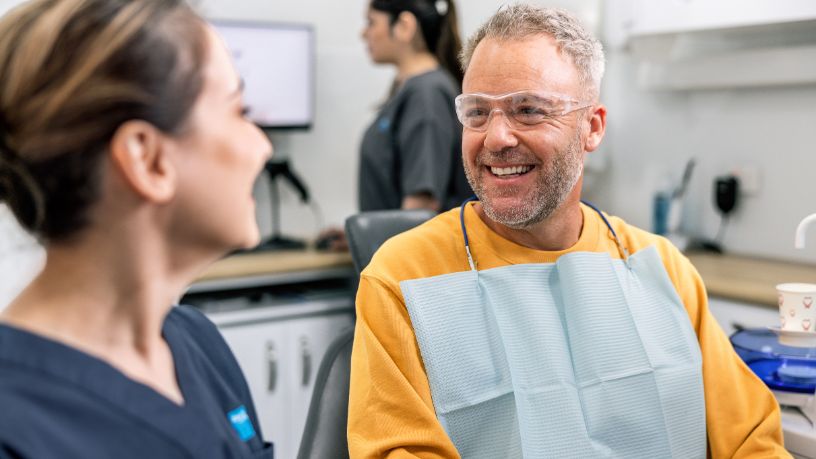On this page
Key takeaways
- Brush your teeth correctly for 2 minutes first thing in the morning and last thing at night.
- If you brush too often or too vigorously it can lead to problems such as sensitivity, enamel abrasion or gum recession.
- Change your toothbrush or electric toothbrush head every three to four months.
What is your teeth cleaning routine? Do you do a quick up and down with your tooth brush, swish water around your mouth to rinse and think the job is done? If you do, you’re not alone. Research shows that the average person brushes their teeth for just 45 seconds.1
Bupa’s Head Dentist Dr Cathryn Madden, says how we brush, and for how long, can make all the difference to the health of our teeth and gums.
The benefits of brushing for 2 minutes
“The aim of toothbrushing is to remove plaque bacteria that forms on the surface of your teeth every day.” Dr Madden explains.
“Removing this daily keeps your teeth and gums healthy by reducing the amount of plaque bacteria around the gum-lines. If this isn’t removed, it leads to inflammation of the gums (red, swollen, bleeding), which is commonly known as gingivitis.
The Australian Dental Association recommends brushing twice a day, for 2 minutes each time.2 Brushing for 2 minutes removes 26% more plaque than brushing for 45 seconds.
“Brushing first thing in the morning and last thing at night is the most important thing to remember,” Dr Madden says.
“Brushing too often or too vigorously can lead to problems such as sensitivity, enamel abrasion or gum recession. And, if you have something sugary or acidic to eat or drink, this can actually soften the enamel slightly, so it is recommended that you wait at least 30-60 minutes after consuming these to brush.”
5 steps to brushing your teeth correctly
A quick once-over your teeth with your brush is not enough to remove dental plaque. Dr Madden suggests thinking of your mouth in terms of quadrants (top left, top right, bottom left, bottom right) then spending 30 seconds on each area, using the following steps to brush your teeth correctly:
- Aim the toothbrush at a 45-degree angle towards the gum line.
- Use a pea-sized amount of toothpaste. Use a gentle circular motion.
- Repeat on the inside surfaces.
- Use a light back and forth motion on the chewing surfaces.
- Spit out the toothpaste after brushing. Don’t rinse as the small amount of fluoridated toothpaste left in your mouth continues to protect against tooth decay.3
Using the right toothbrush
If you normally just use whatever toothbrush you bought on sale, Dr Madden recommends taking a closer look at what you’re choosing.
“Some brushes have really hard bristles and if a lot of pressure is used during brushing, these types of brushes can do damage to gums and enamel,” she says.
“It’s a good idea to ask your dental practitioner to advise you on which type of brush might work best for you. Wearing braces may influence the type of brush you use or for people with reduced manual dexterity, such as arthritis, an electric brush may be best.
“The size of the brush is also an important factor – using a brush with too large a head can be difficult to maneuver around difficult-to-reach areas, such as wisdom teeth.”
Another mistake is keeping your toothbrush for too long. Replace your toothbrush or electric toothbrush head every three to four months, or sooner if the bristles become frayed or distorted. Some brushes have coloured indicator bristles which fade over time, letting you know when it’s time to replace them.
Choosing the best toothpaste
Do you stand in the supermarket aisle in front of shelves of toothpaste and wonder what to buy?
“There are more toothpastes than ever before and the choice can be overwhelming,” Dr Madden observes.
“The important thing is to choose a toothpaste that targets any particular concerns or conditions you may have.
“This can include one that addresses sensitivity in teeth or a toothpaste high fluoride if you have an increased risk of decay.:
“All evidence points towards a fluoride-containing toothpaste to prevent tooth decay4, so make sure this is included in the ingredient list. And, of course, choose one you like the flavour of!”
Find your nearest Bupa Dental Clinic

At Bupa, trust is everything
Our health and wellbeing information is regularly reviewed and maintained by a team of healthcare experts, to ensure its relevancy and accuracy. Everyone's health journey is unique and health outcomes vary from person to person.
This content is not a replacement for personalised and specific medical, healthcare, or other professional advice. If you have concerns about your health, see your doctor or other health professional.
1Andrew Gallagher, DMD; Joseph Sowinski, DDS; James Bowman, MS; Kathy Barrett; Shirley Lowe; Kartik Patel, PhD; Mary Lynn Bosma, DDS; Jonathan E Creeth, PhD (2009) The effect of brushing time and dentifrice on dental plaque removal in vivo. The Journal of Dental Hygiene (2009).
2The Australian Dental Association (Last reviewed 2025). Brushing Teeth. The Australian Dental Association.
3Dental Health Services Victoria. How to Brush Your Teeth. Dental Health Service Victoria.
4The Australian Dental Association (Last reviewed 2025). Fluoride. The Australian Dental Association.
You might also like
The importance of oral hygiene
Bupa dentist Dr Malcolm Duff explains why looking after your teeth and gums should be an important part of your daily routine.
Home teeth whitening: Is it safe?
Home teeth whitening kits might seem like a great idea, but they aren’t always what they’re cracked up to be. Discover whether they’re safe or effective.
7 simple ways to look after your dental health at home
You might have brushed your teeth every day of your life, but you may be getting some things wrong. Learn how to improve your dental game with expert tips.
The hard truth about soft drinks and your teeth
Sugary and acidic drinks can erode tooth enamel, leading to decay. Learn how to minimize damage and maintain a healthy smile.





